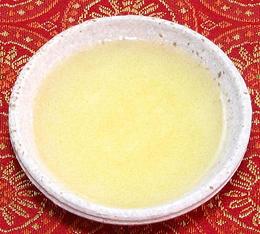 [Asli Ghee (genuine ghee - not vegetable); Ghi (Bengal, Hindi,
Gujarati, Urdu); Samna (Arabic); Roghan-e heivani (Persian); Erbo
(Georgian)]
[Asli Ghee (genuine ghee - not vegetable); Ghi (Bengal, Hindi,
Gujarati, Urdu); Samna (Arabic); Roghan-e heivani (Persian); Erbo
(Georgian)]
Ghee is a very thoroughly clarified and purified cow milk butter fat. It has been, for thousands of years, an important cooking oil through much of Africa, the Near and Middle East, Central and South Asia, and east to Malaysia and Indonesia. Because it has a fairly high content of saturated fats, it is partially solid at normal room temperatures. The photo specimen is in a semi-solid slurry state.
Because it is so thoroughly purified of all moisture and solids, ghee can be used at higher temperatures and is much more resistant to rancidity than more casually purified Clarified Butter. Pots of ghee buried by nomads have been found in excellent condition even after a couple hundred years.
Vegetable Ghee: [Vanaspati ghee, Dalda] Many Indians now use vegetable ghee, similar to Western vegetable shortening, because they've been told it is healthier, and because it is considerably cheaper. Unfortunately much of it is made from trans fats, now known to be very non-healthy. Some is made using Coconut Oil which is probably much healthier. This brings us to points of great controversy (see our Oils and Health page). In India, vegetable ghee is often illegally sold as the real thing.
Ghee has a rich, somewhat buttery flavor and mouth feel. It is used in rice dishes, for frying and as a spread for bread. Its use is very flexible in less developed regions because it needs no refrigeration. It is often used for festive dishes in households that otherwise use cheaper vegetable ghee and oils.
Making Ghee: Ghee is quite easy to make at home, following our recipe Ghee & Clarified Butter.
Buying & Storage: Ghee is easily found in markets serving an Indian or Pakistani community, usually in 1 pint (16 ounce) jars. Store it in a tightly sealed jar away from light and heat and with as little air in the jar as practical and it will last at least a year at room temperature. Because it consists of saturated, monounsaturated and some polyunsaturated fats, it may become stratified in the jar. Just stir it up.
Cooking: Properly made ghee has a smoke point of around 480°F/250°C, so it is very good for high temperature frying, including deep frying. It's main drawback is cost.
Subst: Today, in India, vegetable oils are displacing ghee in many households. It is thought more healthy (questionable, depending on the oil). Über expert Julie Sahni approves of the use of Pure Olive Oil (not virgin) for Indian cooking, but Avocado oil is probably the best substitute, because it has a faintly buttery taste.
Health & Nutrition: These considerations are essentially the same as for butter. Though the American Heart Association has demonized butter (and all other fats and oils with significant content of saturated fats) it is now known to be far healthier than the trans fats they tried so hard to get Americans to use instead.
The whole "saturated fat is bad" mem is now being seriously reconsidered, and the polyunsaturated fats the AHA pushes so strongly are now suspected by some researchers to be more dangerous. Again, see our Oils and Health page (and our Medical Disclaimer page).
oi_gheez 130613 - www.clovegarden.com